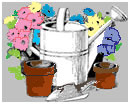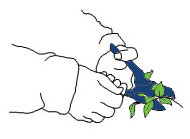Plant Selection
The most important step in interiorscaping is the selection of plants matched correctly with the environmental characteristics of the planting site. Plants differ significantly in their light needs, sensitivity to temperature, and ease of maintenance. This, in turn, impacts their susceptibility to pest problems.
Consistent success with indoor plants is most likely to be achieved by:
- Selecting plants that match the conditions of a given interior environment.
- Purchasing high quality plants from a known and reliable source.
- Acclimating the plant before installation by reducing light, moisture, and fertilizer.
- Watering, fertilizing, cleaning, and pruning appropriately.
Light is probably the most important environmental condition and plants should be placed and grouped according to their need for light. Plants grown under correct conditions are vigorous, compact, and bushy. Color is vibrant, leaves are normal in size, stems are sturdy, and flowering is promoted.
Light helps balance food production (photosynthesis) and consumption (respiration) by the plant. The rate at which plants make their own food is, to a large part, determined essentially by the quantity and duration of available light. The higher the light level, the greater the supply of food. The rate of food consumption is basically determined by temperature. The warmer the temperature, the greater the demand for food. Therefore, in interiorscapes, the low light and warm temperatures create a high demand for food but a slow rate of production.
Plants grown at a light intensity below their optimum will have smaller leaves and less vivid color. They often grow more open and leggy, and pruning may be necessary for compact form. They need to be kept drier than those in bright light and fertilized less frequently. A plant that receives significantly less than its required amount of light may survive for several months to a year, while gradually deteriorating in appearance and vigor.
Three factors lower the light requirement for a plant moved indoors:
- The plant's growth slows dramatically or even stops. This growth reduction triggers a lesser demand for food.
- While the existing leaves cannot change their structure, they can increase their chlorophyll content.
- The new leaves that are produced in the indoor environment will be structured as shade leaves. This has been shown to result in a reduction in the plant's light compensation point.
The light compensation point is defined as the minimum light level at which the amount of food produced by photosynthesis is equal to the amount of food consumed during respiration. Shade leaves have lower light compensation points than sun leaves. Acclimation to low light involves a reduction in the plant's light compensation point either by changes in leaf metabolism so light energy is captured more efficiently in low light or by replacement of inefficient sun leaves with shade leaves tolerant to low light levels.
Artificial light can be used to supplement or replace natural sunlight. Cool-white fluorescent lights used alone or in combination with warm-white fluorescent lights are the most economical and best all-purpose lamps. Typically, a fixture holding two 40-watt tubes is positioned approximately 12 inches above the plants. Most plants need 12 to 16 hours of artificial light per day for good growth. For large specimen plants, use spot or flood lights to maintain good appearance and accent the plant. Lighting design should take into account anticipated use of indoor plants. Indirect and track lighting are very effective design features for this purpose.
 Understanding how a plant reacts to temperature stress is important in making adjustments to correct problems and improve plant longevity. In addition to problems caused by chilling, heat from registers can dry out media and foliage quickly. A minimum/ maximum thermometer will record temperature differences plants may be experiencing in the interior landscape.
Understanding how a plant reacts to temperature stress is important in making adjustments to correct problems and improve plant longevity. In addition to problems caused by chilling, heat from registers can dry out media and foliage quickly. A minimum/ maximum thermometer will record temperature differences plants may be experiencing in the interior landscape.
Most public buildings are heated and cooled with human comfort in mind rather than the growth requirements of indoor plants.
Fortunately, the desirable temperatures for humans fall within the optimum range for most foliage and flowering plants. Daytime temperatures of 70° to 80°F and a nighttime range of 60° to 70°F are satisfactory for most species. Many flowering plants bloom longer at the lower end of these day-night temperature ranges. Variations in temperature ranges should be considered in selecting plants for the interior environment.
Plants differ in their degree of sensitivity to chilling. Generally, most foliage plants cease to grow at 60°F. Temperatures between 45° and 55°F often result in chilling. Chilling causes changes in cell membrane structure, which, in essence, causes the cells to "leak" their contents. This causes a loss in plant vigor and reduced growth. The damage may not be visible for months after chilling has taken place. Many times a secondary problem such as disease will begin to increase due to the loss of vigor. This secondary problem is then blamed for the damage, and chilling goes undetected.
Chilling damage is very subtle and may be very difficult to detect unless maintenance personnel are looking for it. Symptoms of chilling injury include:
- Foliage discoloration.
- Poor growth or wilting.
- Foliage bending or curling.
- Flower bud drop.
- Plant death.
The severity of chilling damage is a result of temperature and length of exposure. For example, exposure to 50°F for 12 hours may cause chilling injury as severe as exposure to 40°F for 2 hours. Chilling injury can result from only a few minutes exposure at freezing temperatures. Plants can get chilled in the truck going to a job site, during transfer from the truck to the indoors, and from exposure to cold winds near doorways.
The following conditions can contribute to chilling injury in the interior environment:
- Shopping malls and public buildings that maintain lower temperatures.
- Air drafts from air conditioning units, doorways, and windows can cause sudden changes in temperature.
- A reduction of temperature in public buildings on weekends and holidays.
The low humidity indoors may also stress plants. During the summer, air conditioning reduces relative humidity and the same is true with heating in the winter. If the growing medium is slightly dry as is common in commercial interiorscapes, plants leaves dry out and become more susceptible to spider mite infestations.
Humidity around plants can be modified. Placing potted plants on shallow trays filled with pebbles and water, locating plants near fountains, or installing humidifiers on HVAC systems can moderate relative humidity for plants and reduce plant stress.
[return]
Maintenance of the Interiorscape
Once plants have been properly placed, their appearance needs to be sustained through proper maintenance and care. Usually, this is limited to watering, fertilizing, cleaning, and pruning.
 Watering indoor plants is a widely misunderstood practice. Water content in the container and plant need for water are difficult to measure accurately. As a result, improper watering is the underlying cause of many plant problems. Watering can also be used to limit the buildup of salts in the growing media. Unless water percolates through the medium, soluble salts from fertilizers may buildup to harmful levels. Water thoroughly at every watering.
Watering indoor plants is a widely misunderstood practice. Water content in the container and plant need for water are difficult to measure accurately. As a result, improper watering is the underlying cause of many plant problems. Watering can also be used to limit the buildup of salts in the growing media. Unless water percolates through the medium, soluble salts from fertilizers may buildup to harmful levels. Water thoroughly at every watering.
Fertilization is necessary for growth and maintenance of plants. A plant's need for fertilizer depends on its growth rate, the amount of leaching that occurs during watering, soil volume, and other factors. Fertilizer levels that were ideal during production can severely damage plants in interiorscapes. Soluble salts in the media can cause root burn when too much fertilizer is applied, when the medium dries out, and when water quality is poor. For many plants, fertilizers are often applied during the summer when light levels are higher.
Plant cleaning includes dust and water-spot removal, leaf shining, and removal of senescent leaves. The leaves of indoor plants can become coated with a heavy layer of dust in a surprisingly short time. This dust and grime interferes with normal leaf functions and makes the plant less attractive. Accumulated dust will shade the leaves and may so drastically reduce light that the plant will eventually die. Dust with a soft brush or cloth moistened with warm water to clean both upper and lower leaf surfaces at least every two or three months.
 Pruning to encourage branching or to remove an entire section of the plant to maintain its intended design or size may be necessary. Pruning may be used to remove insect pests, such as scales, or diseases attacking specific branches.
Pruning to encourage branching or to remove an entire section of the plant to maintain its intended design or size may be necessary. Pruning may be used to remove insect pests, such as scales, or diseases attacking specific branches.
[return]


 Understanding how a plant reacts to
Understanding how a plant reacts to 
